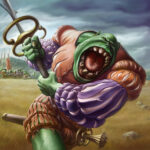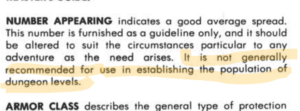I’m sorry, what’s that, Gary?
Don’t I tried this at home kids.
In the Wolflands, while delving the local megadungeon, our intrepid heroes ran into three encounters with orc patrols. Those kinds of numbers indicate something interesting is going on. To explain the streaky nature of things, we decided they must be guarding an orc lair. So we’re going to ignore Gary’s advice, at our peril.
The number of hearing makes for a good guide for the organizational structure of any semi-intelligence monsters. In our case, the entry in the Monster Manual can inform us of how many liters are present, what’s yours might be on with, and what sort of total treasure they might have.
This is too useful to ignore in dungeon settings.
A typical orcish clan of any notable size will have one chief with a large team of bodyguards, one sub chief with a smaller band of bodyguards, and roughly speaking officer for every 10 mooks. That’s pretty good breakdown, and we wound up with 20 patrols of low level guys led by max HP sarge.
We also rolled up a whole lot of pole arms. To minimize our cognitive load when encountering orcs, we want to find out what the patrols, the sub chief, and the chief we’re armed with, all of them have pole arms. To give them a little character, I decided to give each patrol two boworcs, the sub chief and his boys voulges, and the leader and his bodyguards bardiches. A small detail, but it will help break up the monotony.
 The guys in the chat decided that a landsknecht theme would be funny. Which means Kaisorc von Monocle and his subchief Horcler are the boss and mini boss of the Landsknorcts, respectively.
The guys in the chat decided that a landsknecht theme would be funny. Which means Kaisorc von Monocle and his subchief Horcler are the boss and mini boss of the Landsknorcts, respectively.
But what about dungeon design and the solo wargamer? In an outdoor setting, these guys would be on the road with wagonloads of slaves or turtles up in a fort. We have the challenge of slotting them into an Appendix A generated random megadungeon. In a conventionally designed dungeon the author can designate living quarters, a throne room, treasure room and so on. In a random maze of halls and rooms you have to build a mini-game that guarantees placement of the requisite numbers while allowing for some surprises.
Or do you? I don’t think you need any guarantees at all. Guarantees and certainty are the death of surprise and exploration. Instead, I look at the process that follows as a collection of probability fields and potentialities that are likely to provide a semi-plausible outcome while leaving the door open for longshot surprises.
It may be that Kaisorc and his princess are in another castle. That is okay.
We don’t have to worry so much about wandering monsters. Here we are concerned only with the architecture. When we generate a room and the content results indicate the presence of orcs there is a 35% chance we have discovered a lair. This is the chance listed in the MM. There can only be one lair on each level of the dungeon. Each of these will house 25% of the total loot, 2-4 patrols of orcs, half the women and orclets, with a chance of Horcler also being present. A smaller chance exists that the Kaisorc is there too. If Kaisorc is there, then we have found the throne room earlier than expected. Awesome!
Clever readers will have deduced that if the Kaisorc doesn’t appear in the first two lairs, then the third and final “lair”, the throne room must lie on or below the third level of the dungeon. The same rules apply on each level – when the room contents indicate orcs, we check to see if it is a lair. If not, send in patrols adjusted for dungeon level. If so, it’s Kaisorc amd co. (if he survived), with a good chance of Horcler and his boys (if he has survived as well) and the remaining tribal loot.
This setup has some interesting knock-on effects and implications. There may not be a Kaisorc in the Ligmatic Cloister. Our heroes.might kill Kaisorc before Horcler, in which case Horcler takes command. Our heroes might decimate the orc numbers on upper levels leaving the big loot relatively undefended. We might hit the throne room and massive resistance on level one.
The only way to know what the world is like is to play the game.
Which is just how we like it.


